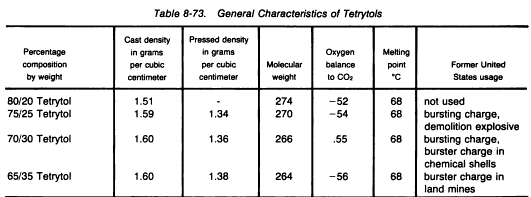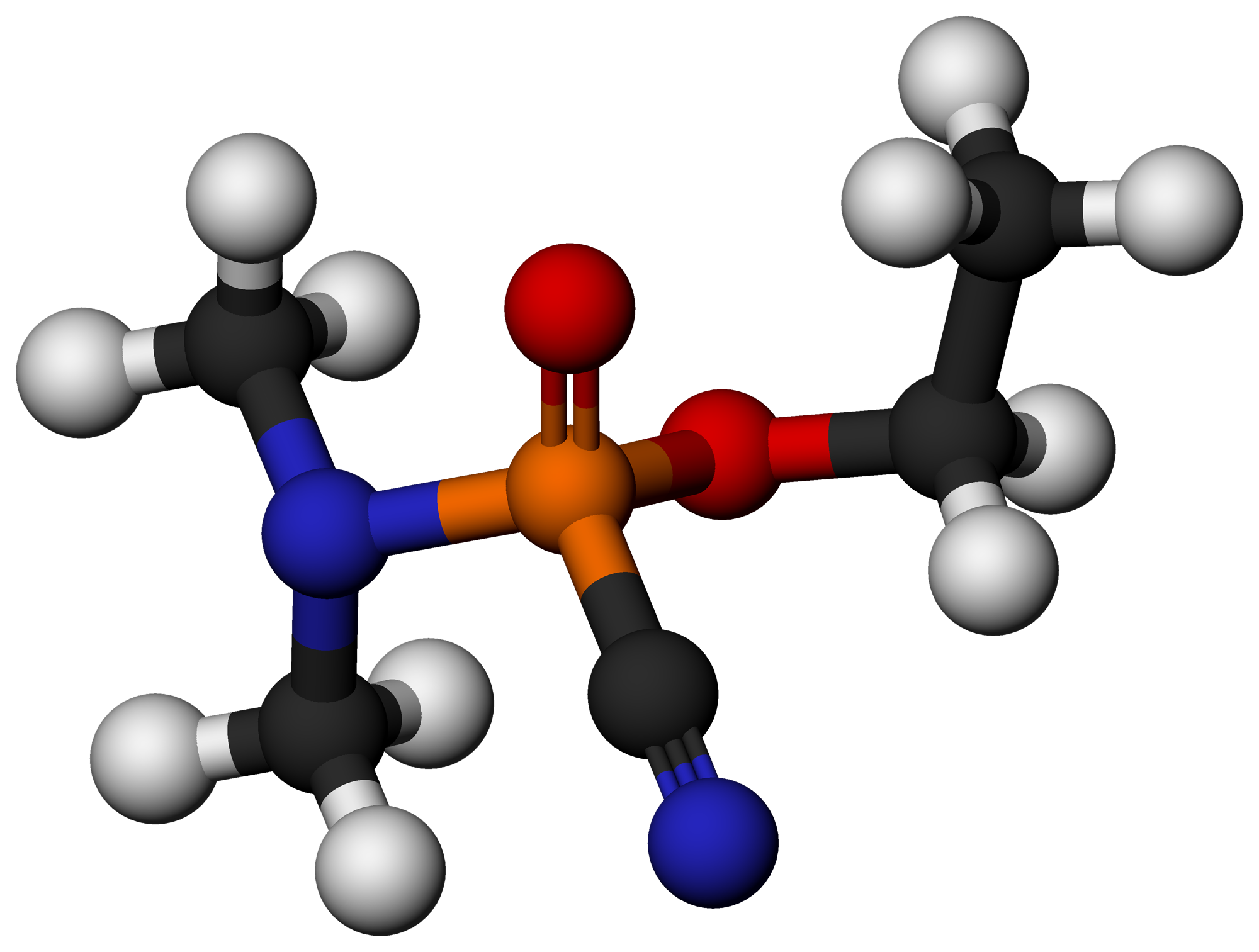|
Tetrytol
Tetrytol is a high explosive, comprising a mixture of tetryl and TNT. Typically, the proportion of ingredients (by weight) is 65%, 70%, 75% or 80% tetryl to 35%, 30%, 25% or 20% TNT. Tetryl and TNT do form a eutectic with a setting point of 67.5 °C, which consists of 55% tetryl and 45% TNT. Hence, cast tetrytol charges consist of solidified suspensions of crystalline tetryl in the solid tetryl-TNT-eutectic. Tetrytol is more sensitive than TNT and less sensitive than tetryl to impact. The detonation velocity of unconfined cast cylindrical charges (1 inch diameter) of tetrytol is between 7290 and 7410 m/s with an average of 7350 m/s for tetrytol 75/25 and 7340 m/s for tetrytol 65/35. For comparison, cylindrical charges of cast pure TNT of similar dimensions are reported to detonate with a velocity of between 6680 and 6990 m/s. Applications of tetrytol are usually military in nature e.g. burster tubes for chemical weapons (e.g. nerve agent shells), blocks of demoliti ... [...More Info...] [...Related Items...] OR: [Wikipedia] [Google] [Baidu] |
High Explosive
An explosive (or explosive material) is a reactive substance that contains a great amount of potential energy that can produce an explosion if released suddenly, usually accompanied by the production of light, heat, sound, and pressure. An explosive charge is a measured quantity of explosive material, which may either be composed solely of one ingredient or be a mixture containing at least two substances. The potential energy stored in an explosive material may, for example, be * chemical energy, such as nitroglycerin or grain dust * pressurized gas, such as a gas cylinder, aerosol can, or BLEVE * nuclear energy, such as in the fissile isotopes uranium-235 and plutonium-239 Explosive materials may be categorized by the speed at which they expand. Materials that detonate (the front of the chemical reaction moves faster through the material than the speed of sound) are said to be "high explosives" and materials that deflagrate are said to be "low explosives". Explosives may a ... [...More Info...] [...Related Items...] OR: [Wikipedia] [Google] [Baidu] |
Tetryl
2,4,6-Trinitrophenylmethylnitramine commonly referred to as tetryl ( C7 H5 N5 O8) is an explosive compound used to make detonators and explosive booster charges. Tetryl is a nitramine booster explosive, though its use has been largely superseded by RDX. Tetryl is a sensitive secondary high explosive used as a booster, a small charge placed next to the detonator in order to propagate detonation into the main explosive charge. Chemical properties Tetryl is a yellow crystalline solid powder material, practically insoluble in water but soluble in acetone, benzene and other solvents. When tetryl is heated, it first melts, then decomposes and explodes. It burns readily and is more easily detonated than ammonium picrate or TNT, being about as sensitive as picric acid. It is detonated by friction, shock, or spark. It remains stable at all temperatures which may be encountered in storage. It is generally used in the form of pressed pellets, and has been approved as the standard bursting ch ... [...More Info...] [...Related Items...] OR: [Wikipedia] [Google] [Baidu] |
Eutectic System
A eutectic system or eutectic mixture ( ) is a homogeneous mixture that has a melting point lower than those of the constituents. The lowest possible melting point over all of the mixing ratios of the constituents is called the ''eutectic temperature''. On a phase diagram, the eutectic temperature is seen as the eutectic point (see plot on the right). Non-eutectic mixture ratios would have different melting temperatures for their different constituents, since one component's lattice will melt at a lower temperature than the other's. Conversely, as a non-eutectic mixture cools down, each of its components would solidify (form a lattice) at a different temperature, until the entire mass is solid. Not all binary alloys have eutectic points, since the valence electrons of the component species are not always compatible, in any mixing ratio, to form a new type of joint crystal lattice. For example, in the silver-gold system the melt temperature ( liquidus) and freeze temperature (s ... [...More Info...] [...Related Items...] OR: [Wikipedia] [Google] [Baidu] |
Detonation Velocity
Explosive velocity, also known as detonation velocity or velocity of detonation (VoD), is the velocity at which the shock wave front travels through a detonated explosive. Explosive velocities are always faster than the local speed of sound in the material. If the explosive is confined before detonation, such as in an artillery shell, the force produced is focused on a much smaller area, and the pressure is significantly intensified. This results in an explosive velocity that is higher than if the explosive had been detonated in open air. Unconfined velocities are often approximately 70 to 80 percent of confined velocities. Explosive velocity is increased with smaller particle size (i.e., increased spatial density), increased charge diameter, and increased confinement (i.e., higher pressure). Typical detonation velocities for organic dust mixtures range from 1400–1650m/s. Gas explosions can either deflagrate or detonate based on confinement; detonation velocities are generally ... [...More Info...] [...Related Items...] OR: [Wikipedia] [Google] [Baidu] |
Characteristics Of Tetrytols
A characteristic is a distinguishing feature of a person or thing. It may refer to: Computing * Characteristic (biased exponent), an ambiguous term formerly used by some authors to specify some type of exponent of a floating point number * Characteristic (significand), an ambiguous term formerly used by some authors to specify the significand of a floating point number Science *''I–V'' or current–voltage characteristic, the current in a circuit as a function of the applied voltage *Receiver operating characteristic Mathematics * Characteristic (algebra) of a ring, the smallest common cycle length of the ring's addition operation * Characteristic (logarithm), integer part of a common logarithm * Characteristic function, usually the indicator function of a subset, though the term has other meanings in specific domains * Characteristic polynomial, a polynomial associated with a square matrix in linear algebra * Characteristic subgroup, a subgroup that is invariant under all autom ... [...More Info...] [...Related Items...] OR: [Wikipedia] [Google] [Baidu] |
Chemical Weapons
A chemical weapon (CW) is a specialized Ammunition, munition that uses chemicals chemical engineering, formulated to inflict death or harm on humans. According to the Organisation for the Prohibition of Chemical Weapons (OPCW), this can be any chemical compound intended as a weapon "or its Precursor (chemistry), precursor that can cause death, injury, temporary incapacitation or sensory irritation through its chemical action. Munitions or other delivery devices designed to deliver chemical weapons, whether filled or unfilled, are also considered weapons themselves." Chemical weapons are classified as weapons of mass destruction (WMD), though they are distinct from nuclear weapons, biological warfare, biological weapons, and radiological weapons. All may be used in warfare and are known by the military acronym NBC (for nuclear, biological, and chemical warfare). Weapons of mass destruction are distinct from conventional weapons, which are primarily effective due to their explos ... [...More Info...] [...Related Items...] OR: [Wikipedia] [Google] [Baidu] |
Nerve Agent
Nerve agents, sometimes also called nerve gases, are a class of organic chemicals that disrupt the mechanisms by which nerves transfer messages to organs. The disruption is caused by the blocking of acetylcholinesterase (AChE), an enzyme that catalyzes the breakdown of acetylcholine, a neurotransmitter. Nerve agents are acetylcholinesterase inhibitors used as poison. Poisoning by a nerve agent leads to constriction of pupils, profuse salivation, convulsions, and involuntary urination and defecation, with the first symptoms appearing in seconds after exposure. Death by asphyxiation or cardiac arrest may follow in minutes due to the loss of the body's control over respiratory and other muscles. Some nerve agents are readily vaporized or aerosolized, and the primary portal of entry into the body is the respiratory system. Nerve agents can also be absorbed through the skin, requiring that those likely to be subjected to such agents wear a full body suit in addition to a respirato ... [...More Info...] [...Related Items...] OR: [Wikipedia] [Google] [Baidu] |
Artillery Shell
A shell, in a military context, is a projectile whose payload contains an explosive, incendiary, or other chemical filling. Originally it was called a bombshell, but "shell" has come to be unambiguous in a military context. Modern usage sometimes includes large solid kinetic projectiles that is properly termed shot. Solid shot may contain a pyrotechnic compound if a tracer or spotting charge is used. All explosive- and incendiary-filled projectiles, particularly for mortars, were originally called ''grenades'', derived from the French word for pomegranate, so called because of the similarity of shape and that the multi-seeded fruit resembles the powder-filled, fragmentizing bomb. Words cognate with ''grenade'' are still used for an artillery or mortar projectile in some European languages. Shells are usually large-caliber projectiles fired by artillery, armored fighting vehicles (e.g. tanks, assault guns, and mortar carriers), warships, and autocannons. The shap ... [...More Info...] [...Related Items...] OR: [Wikipedia] [Google] [Baidu] |
Shaped Charge
A shaped charge is an explosive charge shaped to form an explosively formed penetrator (EFP) to focus the effect of the explosive's energy. Different types of shaped charges are used for various purposes such as cutting and forming metal, initiating nuclear weapons, penetrating armor, or perforating wells in the oil and gas industry. A typical modern shaped charge, with a metal liner on the charge cavity, can penetrate armor steel to a depth of seven or more times the diameter of the charge (charge diameters, CD), though greater depths of 10 CD and above have been achieved. Contrary to a misconception (possibly resulting from the acronym for ''high-explosive anti-tank'', HEAT) the shaped charge EFP jet does not depend in any way on heating or melting for its effectiveness; that is, the EFP jet from a shaped charge does not melt its way through armor, as its effect is purely kinetic in nature – however the process does create significant heat and often has a significant ... [...More Info...] [...Related Items...] OR: [Wikipedia] [Google] [Baidu] |



